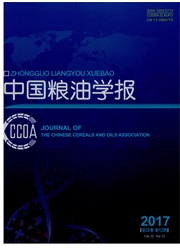

 中文摘要:
中文摘要:
油茶籽油甘三酯在优化条件下得到良好分离,在14种甘三酯中含量水平前三的分别为OOO+SLO(74.21%)、OOP(10.64%)和OOL+SLL(5.19%)。方差分析表明来自不同产地的油茶籽油甘三酯分布情况存在差异。油茶籽油在深层煎炸过程(180℃)中甘三酯的总体损失率为47.85%,ECN40、ECN42、ECN44、ECN46、ECN48和ECN50区的甘三酯损失率分别为86.73%、91.52%、75.97%、45.01%和55.30%。LLL和PPL历经40h煎炸后完全降解。与深层煎炸油样相比,加热(180℃)样品中甘三酯的降解程度相对降低。偏相关分析表明油茶籽油甘三酯在深层煎炸过程中的降解速率与极性组分的生成速率呈负相关。
 英文摘要:
英文摘要:
The camellia oleosa seed oil triacylglycerol was separated completely under optimistic condition, in which OOO + SLO (74.21%), OOP ( 10.64% ) and OOL + SLL (5.19%) were top three compounds among 14 triacylglycerol triacylglycerols. The analysis of variance showed that the difference happened to camellia oleosa seed oil triacylglycerols from different production areas. The overall loss ratio of camellia oleosa seed oil during deep frying (180 ℃ ) were 47.85%, and the loss ratio of triacylglycerols in each partition (ECN40, ECN42, ECN44, ECN46, ECN4s and ECN50) were 86.73% , 91.52% , 75.97% , 45.01% and 55.30% , respectively. LLL and PPL were totally decomposed after frying treatment for 40 h. Compared with deep frying samples, the degradation level of heating ( 180 ℃ ) oil was relatively lower. Partial correlation analysis showed that a negative correlation between the degradation ratio of camellia oleosa seed oil triacylglycerol during deep frying and generation ration of polar compounds existed.
 同期刊论文项目
同期刊论文项目
 同项目期刊论文
同项目期刊论文
 Antioxidant activity of phenolic compounds in bulk camellia oil and corresponding oil in water (o/w)
Antioxidant activity of phenolic compounds in bulk camellia oil and corresponding oil in water (o/w) Development of quantitative analysis of fatty acid for monitoring changes of fatty acid profile of c
Development of quantitative analysis of fatty acid for monitoring changes of fatty acid profile of c 期刊信息
期刊信息
